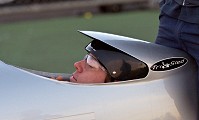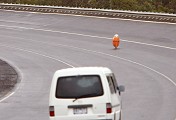Tri-Sled now publishes all news items on our website: www.trisled.com.au/news
Please update your links accordingly.
Please update your links accordingly.
 Sled-Edge one hour speed record attempt
Sled-Edge one hour speed record attempt Full of confidence and enthusiasm, the team was keen to get serious. The US$25,000 Dempsey–MacCready Hour Record prize was the perfect motivator. The prize, which expired at the end of June 2006, rewarded the first single-rider to equal or surpass 90 kilometers (55.924 miles) in just one hour.
Full of confidence and enthusiasm, the team was keen to get serious. The US$25,000 Dempsey–MacCready Hour Record prize was the perfect motivator. The prize, which expired at the end of June 2006, rewarded the first single-rider to equal or surpass 90 kilometers (55.924 miles) in just one hour. There was very little time to waste. Tim managed to secure limited access to the Holden Lang Lang proving ground which was the perfect venue for an attempt. Ben contacted the Tri-Sled racing team and recruited Scott Hawke as an assistant technician and Jeff Neilson as “the engine” with the full support of his wife Sharna.
There was very little time to waste. Tim managed to secure limited access to the Holden Lang Lang proving ground which was the perfect venue for an attempt. Ben contacted the Tri-Sled racing team and recruited Scott Hawke as an assistant technician and Jeff Neilson as “the engine” with the full support of his wife Sharna. 
 However, unlike the true-form molds used for Whoops, Ben decided that a few “nip-n-tucks” were needed to reduce the frontal area for the Sled-Edge speed bike and gain a little more speed. In total he took 60mm out of the height and 20mm out of the width to get Jeff extra snug inside the fairing. Ben also designed and constructed a custom drive system and crank set into a Chromoly chassis to allow for the even tighter fit.
However, unlike the true-form molds used for Whoops, Ben decided that a few “nip-n-tucks” were needed to reduce the frontal area for the Sled-Edge speed bike and gain a little more speed. In total he took 60mm out of the height and 20mm out of the width to get Jeff extra snug inside the fairing. Ben also designed and constructed a custom drive system and crank set into a Chromoly chassis to allow for the even tighter fit. During the first test session at the proving ground, the Sled-Edge was configured into a camera bike. Ben’s aerodynamically designed pod on top of the bike contained a video camera and Jeff had a small screen in the bike to see the road ahead. This proved to be the most testing session for the Sled-Edge team. With the low winter sun affecting Jeff’s vision and the lack of time available to get used to camera steering, they realised we were going to have to rethink video vision for the initial attempt.
During the first test session at the proving ground, the Sled-Edge was configured into a camera bike. Ben’s aerodynamically designed pod on top of the bike contained a video camera and Jeff had a small screen in the bike to see the road ahead. This proved to be the most testing session for the Sled-Edge team. With the low winter sun affecting Jeff’s vision and the lack of time available to get used to camera steering, they realised we were going to have to rethink video vision for the initial attempt.
 Following four weeks of hard work and development, bad luck with the weather kept the Sled-Edge grounded on the designated day of the trial. Holden were only able to grant the team one day at the track within the time deadline and the conditions were not safe or suitable to run.
Following four weeks of hard work and development, bad luck with the weather kept the Sled-Edge grounded on the designated day of the trial. Holden were only able to grant the team one day at the track within the time deadline and the conditions were not safe or suitable to run. Congratulations to veteran HPV rider Freddy Markham. Despite the heat he managed to set a new world record of 85.991 km on one of the last days of the trial! For more information on the Arizona speed attempts click here.
Congratulations to veteran HPV rider Freddy Markham. Despite the heat he managed to set a new world record of 85.991 km on one of the last days of the trial! For more information on the Arizona speed attempts click here.